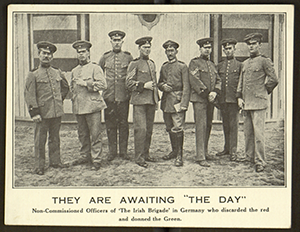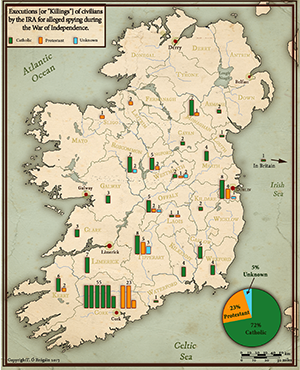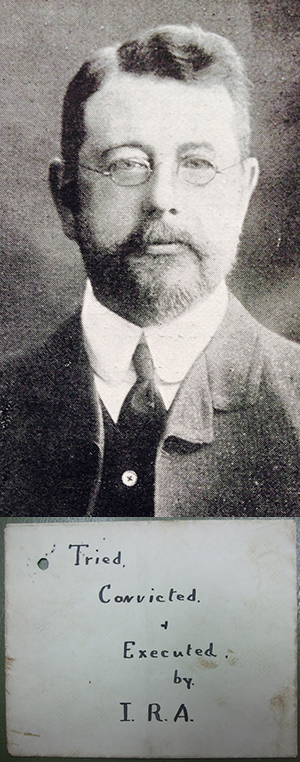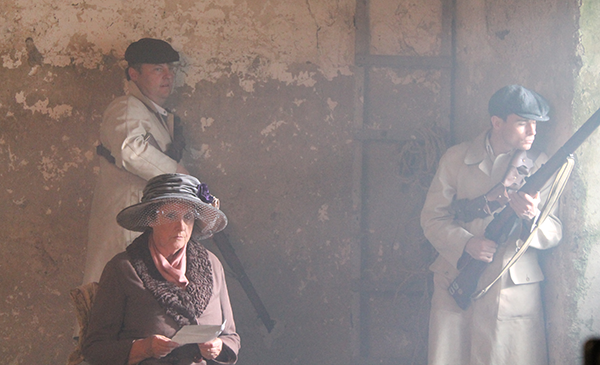‘Spies and informers beware!’
Published in Features, Issue 3 (May/June 2017), Revolutionary Period 1912-23, Volume 25IRA executions of alleged civilian spies during the War of Independence.
By Pádraig Óg Ó Ruairc
The ‘intelligence war’ was undoubtedly one of the most important aspects of the Irish War of Independence and remains one of the most controversial today. For the British, the best way to defeat the insurgency was to acquire accurate intelligence about IRA personnel, their supply of arms and operations. Prior to the 1916 Rising they had relied on the Royal Irish Constabulary (RIC) and the Dublin Metropolitan Police (DMP), but the widespread closure of rural RIC barracks following IRA attacks, the success of Sinn Féin’s police boycott and the consequent mass resignation of Irish-born constables meant that the British became increasingly dependent on civilians for information.
Given the previous role of spies and informers in compromising the insurrections of 1798 and 1867, the IRA was acutely aware of the importance of stopping the flow of intelligence to its enemy by identifying and eliminating British agents. As a guerrilla army relying on secrecy and mobility, the IRA was rarely in a position to punish suspected spies by holding them prisoner. Instead, the republicans inflicted a variety of other punishments on these suspects. Some received threatening notices; others suffered economic boycott or were forced into exile. In the most extreme cases republicans captured and killed civilians whom they claimed were spies and informers. The IRA killed a total of 184 civilians accused of spying during the War of Independence.

Above: Timothy Quinlisk (far right), a Catholic ex-soldier and former member of Casement’s Irish Brigade, was one of the first civilians executed by the IRA as a British spy, in Ballyphehane, Co. Cork, in February 1920. (Joseph McGarrity Collection, Villanova University)
The intensity of the intelligence war and the number of related IRA killings varied widely throughout Ireland. (See map.) The execution of suspected spies was almost exclusively a ‘Southern’ phenomenon. Apart from a cluster in Armagh, Cavan and Monaghan, IRA execution of spies was almost unknown in Ulster. The largest number of IRA executions (66) occurred in Cork. The second-highest number was in Tipperary, where sixteen civilians accused of spying for the British forces were killed. The IRA in Dublin killed at least thirteen civilians for spying. These three counties alone accounted for more than half of such killings nationally. This is unsurprising, since these counties were the scene of intense IRA activity and were amongst the first districts to be placed under martial law by the British forces.
Nevertheless, the number of executions did not always correspond to the level of local IRA activity. The IRA in Clare mounted a very strong military campaign that resulted in the deaths of 41 British troops but only three executions of civilians accused of spying. By contrast, a desultory IRA campaign in Meath inflicted just three fatalities on British forces yet killed four alleged spies. The only IRA execution to occur outside of Ireland during the conflict was the assassination of a British agent in Middlesex, England, although a number of later attempts were made after the Truce to kill suspected spies who had fled to the USA.
 Anti-Protestant sectarianism?
Anti-Protestant sectarianism?
Given the potential threat posed by spies and informers, the execution of suspected British intelligence agents was a logical and necessary action from a republican perspective. It has repeatedly been alleged, however, that the IRA used the ‘intelligence war’ as a pretext to murder Protestants, ex-soldiers and Travellers. These accusations surfaced in the memoirs of British veterans published shortly after the conflict. Hugh Pollard, a former RIC press officer, claimed that these killings were primarily motivated by agrarianism and that those killed ‘had nothing whatever to do with the authorities … these were private murders, possibly in pursuit of old faction feuds, but carried out under the all-embracing Irish cloak of patriotism’. The history of the British Army’s 6th Division suggested a possible sectarian motive to these killings, noting that ‘a large number of Protestant Loyalists were murdered and labelled as spies’ and that ‘a regular murder campaign was instigated against Protestant Loyalists and anyone who might be suspected of being an informer quite irrespective of whether he really was one or not’.

Top: Alfred Reilly, manager of Thompson’s Bakery in Cork, was shot by the IRA as a suspected spy on 9 February 1921. Pinned to his chest was an envelope on which the words ‘Beware of the IRA’ had been written in pencil. Like a third of the alleged spies killed in County Cork, Reilly was a Protestant.
Above: The label attached to the body of Patrick Larmour, an IRA Volunteer from Monaghan who ‘broke’ under British interrogation and was executed by his comrades.
The largest number of Protestant civilians killed by the IRA as alleged spies was in Cork, where 21 (c. 32%) were Protestant. Although this figure appears to be disproportionately high, there were very large Protestant communities in Cork that were staunchly loyalist in politics and, consequently, may have been more willing to risk the IRA’s wrath by assisting the British forces. The British Army’s ‘Record of the Rebellion in Ireland’ reported that Protestant loyalists in west Cork had actively assisted the British forces ‘in the Bandon Valley … there were many Protestant farmers who gave information … it proved almost impossible to protect these brave men many of whom were murdered’.
The IRA killed one alleged spy in Sligo and a further two in Leitrim—these areas are exceptional as the only counties where all of those killed as spies were Protestant. Even in these two counties, however, it is problematic to assume automatically that the three killings concerned were sectarian. The widow of one of the victims testified that her husband, William Latimer, a Protestant farmer, had supplied information to the RIC and she did not ascribe a sectarian motive to his killing. Lionel Curtis, a British government adviser who visited Ireland in 1921, reported that Southern Irish Protestants did not complain of sectarian persecution and were targeted ‘not by reason of their religion, but rather because they are under suspicion as Loyalists’.
Ex-servicemen, tramps and Travellers
At least 88 of the civilians killed by the IRA as spies (approximately 48%) were ex-servicemen. The vast majority of these had served in the British Army and the remainder were veterans of the Royal Navy. A further eight (c. 4%) were ex-RIC constables. One of those killed, Hugh Duffy, was a member of the Ulster Special Constabulary, and another, William Nolan, had applied to join the RIC. Approximately 2% of those shot as spies were IRA Volunteers. At least 86 of those killed (c. 46%) had no military or police service. Some historians, notably Jane Leonard, have suggested that the IRA were prejudiced against Irishmen who had served in the British Army. She contended that ex-soldiers ‘weakened the revolution’s effectiveness by refusing to join Sinn Féin, subscribe to its funds, or obey the rulings of its courts’.
In fact, however, former British soldiers were actively recruited by the IRA and occupied important leadership positions within it. Such men included Emmet Dalton, the IRA’s director of training; Tom Barry, training officer for the West Cork Brigade; Jim Tormey, commandant of the Athlone Brigade; and Ignatius O’Neill, commander of the Mid-Clare Brigade. Far from being prejudiced against ex-soldiers, the IRA valued and promoted them because of their military experience. William Corrie, an ex-British soldier who joined the IRA’s Dublin Brigade, recalled: ‘During my service with the IRA I met hundreds of ex-servicemen.’
Nevertheless, the IRA had reason to be suspicious of ex-soldiers with strong loyalist sympathies or those whose financial difficulties gave them an economic incentive to engage in intelligence work. Irishmen who had served in the British forces were more likely to suffer economic hardship than their British counterparts. Unemployment amongst ex-soldiers in post-war Ireland reached 46% compared to just 10% in Britain. The economic difficulties of ex-servicemen, coupled with their military training and previous loyal service to the British Crown, made them ideal candidates for recruitment by the British for counter-insurgency work. The British made a number of attempts to exploit ex-soldiers’ associations to gather intelligence on the IRA. Whilst the IRA nationally killed a large number of ex-servicemen, including in Limerick and Cork city, the British were responsible for the majority of ex-soldiers killed in these areas.
It has also been suggested that the IRA exercised prejudice against tramps and Travellers during the conflict. Was this, perhaps, related to the practice of British agents, who often disguised themselves as such on intelligence-gathering missions? Kenneth Strong, a British intelligence officer stationed in Tullamore, travelled the countryside disguised ‘as the owner of a small donkey cart’ when meeting locals whom he had recruited as informers. Hugh McIvor, a Black and Tan stationed in Bandon, recalled that a senior RIC officer led a ‘special squad’ of RIC constables who ‘all dressed like old farmers’ whilst on intelligence-gathering operations. Given that British agents disguised themselves in this manner, is it any wonder that the IRA harboured deep suspicions about vagrants, a number of whom were killed as spies?
Taboos—IRA Volunteers, women and clergymen
Only four of those executed by the IRA as suspected spies came from within their own ranks. One of these was Patrick Larmour, an IRA Volunteer from Monaghan who was arrested by the British and ‘broke’ under interrogation. After being released from custody, Larmour told his superior officers in the IRA what had happened. Although it is unlikely that he gave the British any significant information, he was shot as a spy. The execution of IRA Volunteers as alleged spies proved highly divisive in republican circles. Debate as to the guilt or innocence of Patrick D’Arcy, an IRA Volunteer shot as an alleged spy in west Clare, raged for decades after his death. James Dalton, an IRA officer in Limerick city, was shot as the result of an internal IRA feud. The allegation that Dalton was a spy seems to have been concocted after the killing, and a short time later Dáil Éireann took the unprecedented step of investigating Dalton’s death and issuing a public statement declaring his innocence.
Just three women were killed by the IRA for spying, the most infamous incident being the execution of Mrs Maria Lyndsay. Mrs Lyndsay was abducted by the IRA in March 1921 because she had informed the British Army about an IRA ambush at Dripsey, Co. Cork. Acting on her information, the British Army had launched a surprise attack, capturing five IRA Volunteers who were later tried by courts martial and executed. The IRA had warned the British that they would kill Lyndsay if the republican prisoners were executed. They duly carried out their threat and buried her body in secret. Fr Shinnick, a Catholic priest who had assisted Mrs Lyndsay, was not killed. Although the killing of women was a taboo rarely broken, killing a clergyman of any denomination would have been even more controversial, and although the IRA knew of several clergymen, both Catholic and Protestant, who had gathered intelligence for the British, none of them were executed.

Above: Mrs Maria Lyndsay—one of just three women shot by the IRA for spying—prior to her execution in January 1921, as re-enacted in TV3’s 2013 documentary In the name of the Republic. (Tile Films)
Spy labels, firing squads and ‘the disappeared’
The majority of civilians killed by the IRA as suspected spies were shot dead. As a warning to others, their bodies were usually deposited in public places with an accompanying label reading ‘Shot by IRA—spies and informers beware!’ Traits of these killings included tying the condemned to a fixed post, execution by firing squad and the use of ‘spy’ labels mimicking contemporary British military practices. A few IRA units in Roscommon and Meath killed suspected spies by drowning rather than shooting, a bizarre method of execution never fully explained. Another unusual practice adopted by the IRA was the ‘disappearance’ of suspected spies, whose bodies were secretly buried instead of being labelled and dumped in a public area for discovery. British forces were also known to ‘disappear’ some of their victims, but it was far more common for the IRA to do so. The practice appears to have been adopted in circumstances where the IRA felt that the killing would not be approved of by the wider community, such as the shooting of Mrs Lyndsay. It may also have been a pragmatic measure to hide evidence of these killings.
The IRA tactic of hiding these bodies remains controversial, probably because of similarities with those ‘disappeared’ by the Provisional IRA in the more recent Northern conflict. The practice, however, was relatively rare during the War of Independence. The recent claim by Eunan O’Halpin that approximately 200 of the IRA’s opponents were ‘abducted, executed and … secretly disposed of’ is undoubtedly a gross overestimate. Fewer than 25 of those executed as spies during the War of Independence were ‘disappeared’ by the IRA; the majority of their remains have yet to be recovered. Given that in most cases there is no historical documentation publicly available that can conclusively confirm whether those killed by the IRA as spies were in fact British agents, it is likely that these killings will remain controversial, whether or not the victims were ‘disappeared’.
Pádraig Óg Ó Ruairc lives in County Cork and has a Ph.D in history from the University of Limerick.
FURTHER READING
A. Bielenberg & S. Donnelly, ‘Cork Spy Files’, www.theirishrevolution.ie (2016).
J. Borgonovo, Spies, informers and the Anti-Sinn Féin Society (Dublin, 2006).
P. Ó Ruairc, Truce—murder, myth and the last days of the Irish War of Independence (Cork, 2016).
















